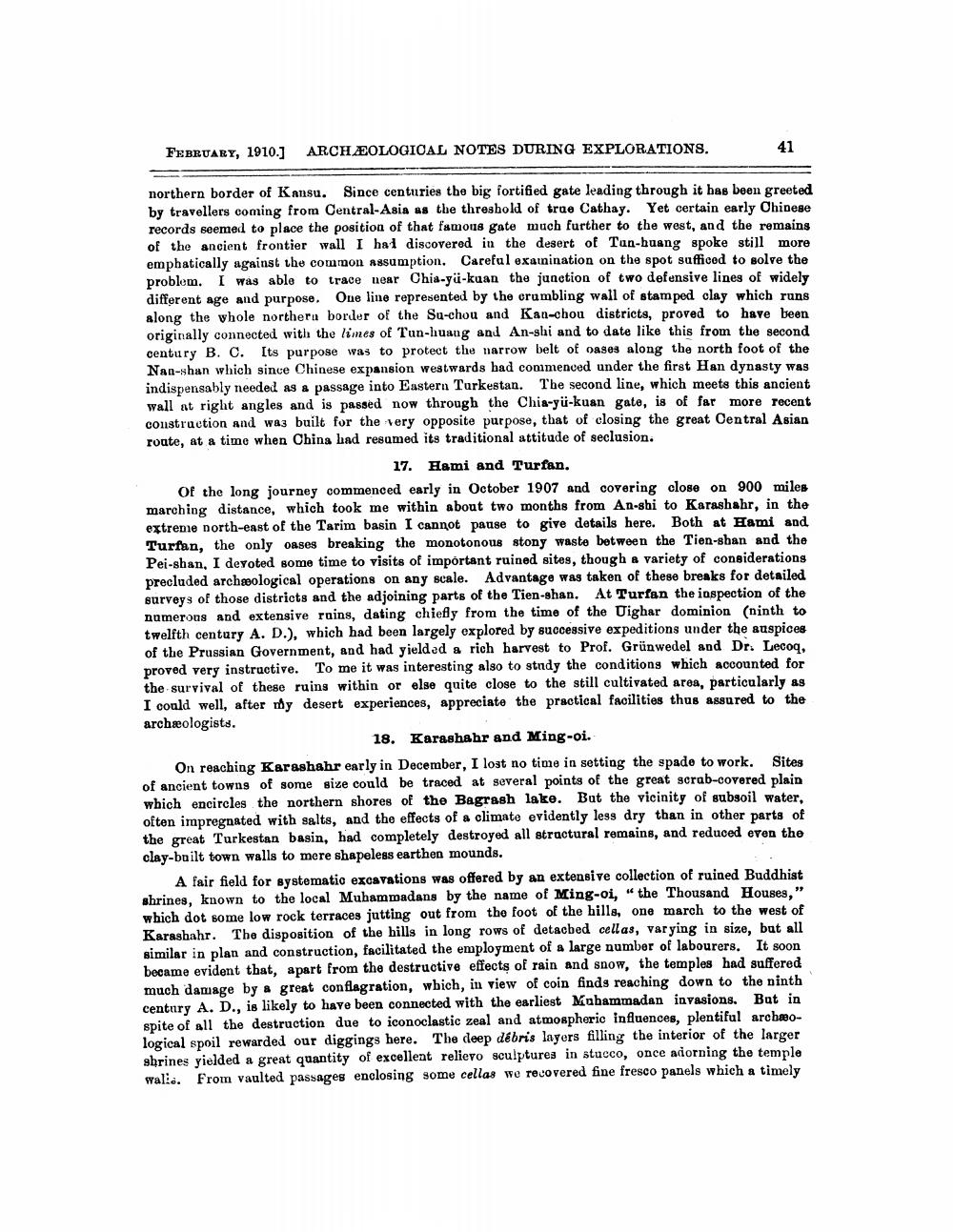________________
FEBRUARY, 1910.) ARCHÆOLOGICAL NOTES DURING EXPLORATIONS.
41
northern border of Kansu. Since centuries the big fortified gate leading through it has been greeted by travellers coming from Central-Asia as the threshold of trae Cathay. Yet certain early Chinese records seemed to place the position of that famous gate much further to the west, and the remains of the ancient frontier wall I had discovered in the desert of Tan-buang spoke still more emphatically against the common assumption. Careful examination on the spot suffiood to solve the problem. I was able to trace near Chia-yü-kuan the junction of two defensive lines of widely different age and purpose. Oue line represented by the crumbling wall of stamped clay which runs along the whole northern border of the Su-chou and Kan-chou districts, proved to have been originally connected with the limes of Tun-huang and An-shi and to date like this from the second century B. C. Its purpose was to protect the narrow belt of oases along the north foot of the Nag-shan which since Chinese expansion westwards bad commenced under the first Han dynasty was indispensably needed as a passage into Eastern Turkestan. The second line, which meets this ancient wall at right angles and is passed now through the Chia-yü-kuan gate, is of far more recent construction and was built for the very opposite purpose, that of closing the great Central Asian route, at a time when China had resumed its traditional attitude of seclusion.
17. Hami and Turfan. Of the long journey commenced early in October 1907 and covering close on 900 miles marching distance, which took me within about two months from An-shi to Karashahr, in the extreme north-east of the Tarim basin I cannot pause to give details here. Both at Hami and Turfan, the only oases breaking the monotonous stony waste between the Tien-shan and the Pei-shan, I devoted some time to visits of important ruined sites, though a variety of considerations precluded archeological operations on any scale. Advantage was taken of these breaks for detailed surveys of those districts and the adjoining parts of the Tien-shan. At Turfan the inspection of the numerous and extensive rains, dating chiefly from the time of the Uighar dominion (ninth to twelfth century A. D.), which had been largely explored by successive expeditions under the auspices of the Prussian Government, and had yielded a rich harvest to Prof. Grünwedel and Dr. Lecoq, proved very instructive. To me it was interesting also to study the conditions which accounted for the survival of these ruins within or else quite close to the still cultivated area, particularly as I could well, after my desert experiences, appreciate the practical facilities thus assured to the archæologists.
18. Karashahr and Ming-oi. On reaching Karashahr early in December, I lost no time in setting the spade to work. Sites of ancient towns of some size could be traced at several points of the great scrab-covered plain which encircles the northern shores of the Bagrash lake. But the vicinity of subsoil water, often impregnated with salts, and the effects of a climate evidently less dry than in other parts of the great Turkestan basin, had completely destroyed all stractural remains, and reduced even the clay-built town walls to mere shapeless earthen mounds.
A fair field for systematio excavations was offered by an extensive collection of ruined Buddhist shrines, known to the local Muhammadans by the name of Ming-oi, “the Thousand Houses," which dot some low rock terraces jutting out from the foot of the hills, one march to the west of Karashahr. The disposition of the hills in long rows of detached cellas, varying in size, but all similar in plan and construction, facilitated the employment of a large number of labourers. It soon became evident that, apart from the destructive effects of rain and snow, the temples had suffered much damage by a great conflagration, which, in view of coin finds reaching down to the ninth century A. D., is likely to have been connected with the earliest Muhammadan invasions. But in spite of all the destruction due to iconoclastic zeal and atmospheric influences, plentiful archæological spoil rewarded our diggings here. The deep débris layers filling the interior of the larger shrines yielded a great quantity of excellent relievo sculptures in stucco, once adorning the temple walie. From vaulted passages enclosing some cellas we recovered fine fresco panels which a timely




